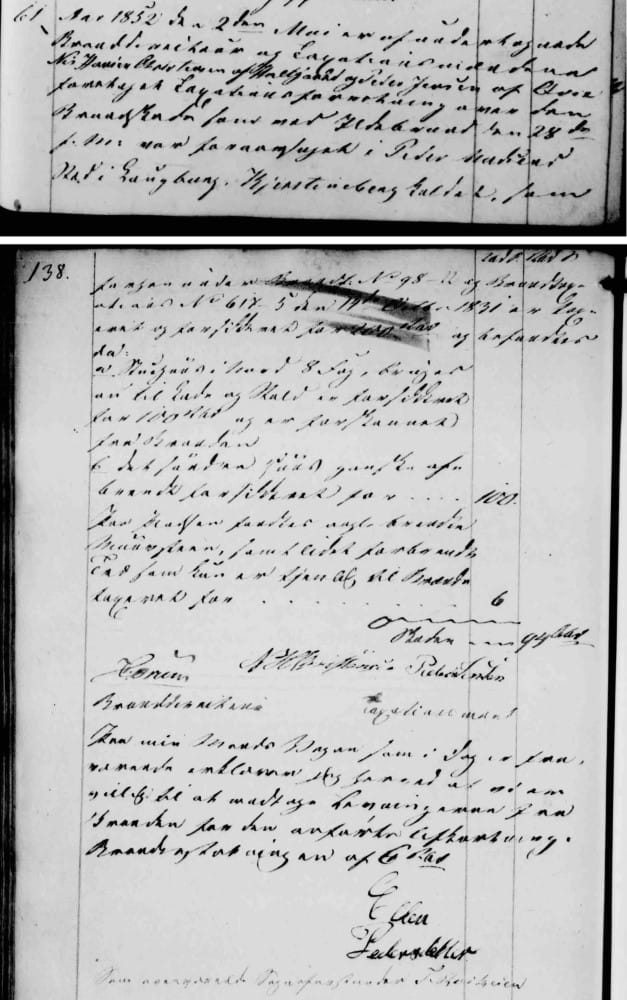I can help you examine in which farm or house your Danish ancestors lived, and whether they owned or rented it. A house history can reveal whether the buildings where your ancestors lived, still exist and at which address the place lies today.
A research of the history of a house or farm in Denmark typically involves an examination of the following source types:
- Deeds and mortgage books
- Real property registries
- Cadaster books
- Maps
- Land value tax records
- Fire insurance records
Fire insurance records describe each building in terms of size, building materials, and usage. If a house or farm caught fire, the damages were assessed, so the right insurance amount could be paid out. An example of such an assessment is shown below.

Translation of the record:
Year 1852 on 2nd May the undersigned fire inspector and the assessment men Nis Hansen Christensen of Haltgaard and Peder Jensen of Qvie have held an assessment business of the fire damages, which by a fire on 28th last month had been caused to Peder Madsen's place in Laugborg, called Kjerstineberg, which is previously assessed under fire insurance no. 98-22 and fire assessment no. 617-5 on 14th October 1831 and insured for 200 Rbd and was then found to be:
-
-
- The main house to the north 8 sections, is now used for barn and stables is insured for 100 Rbd and is spared of the fire
- The southern house totally burned down insured for 100 Rbd.
-
At the lot was found some burnt bricks and a bit of burnt wood which is only suitable for firewood assessed at 6 Rbd.
The damage [total] 94 Rbd.
[Original signatures]
C:ørum N H Christensen Peder Jensen
Fire inspector Assessment men
On behalf of my husband who is absent today I hereby declare that we are willing to receive the remains of the fire at the stated deduction in the fire costs at 6 Rbd.
[Original signature] Ellen Pedersdatter
[Original signature] As supervisor Parish Clerk T. Raskesen1
The record not only provides details about the fire and the property. It provides evidence of the relationship between Peder Madsen and Ellen Pedersdatter.
One record often leads to other records. The details in this record point to the insurance record and the previous assessment, which should both be examined. Furthermore, it is reasonable to expect that the building, which had burned down, was rebuilt, and then another assessment took place after the rebuild.
Extracting relevant details from each record and identifying other records to be examined are essential steps of all my research projects. If you are interested in hiring me to research your Danish ancestors, contact me so we can talk about the options for your family.
Source References:
- Ribe Amts Branddirektorat [Ribe county fire directorate], taksationsprotokol for Øster Horne Herred [assessment record book for Øster Horne district] 1845-1880, pages 137-138, entry 61; digital image, The Danish National Archives, Arkivalieronline (https://www.sa.dk/ao-soegesider/da/billedviser?epid=15292408#187041,31726579 : accessed 20 January 2024). Rbd. is short for rigsbankdaler, which was the Danish currency at that time.
- The image at the top of the post: Map of Qvie Town's lands in Ansager Parish (Øster [Horne] District, Ribe County), drawn 1817; digital image, Styrelsen for Dataforsyning og Infrastruktur, Historiske kort (https://historiskekort.dk : accessed 20 January 2024) > search for "Kvie" & Map Group: Matrikelkort > click the line with the map valid from 1819 to 1861. Peder Madsen's place lay in Lavborg (previously spelled Laugborg) in Kvie property area (previously spelled Qvie) in Ansager Parish.




